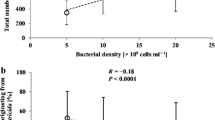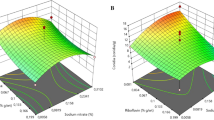Abstract
The effects of culture medium formulations on the kinetics of infective juvenile (IJ) production of the entomopathogenic nematode Steinernema carpocapsae in submerged monoxenic culture, were studied at the cylindrical-bottle scale using six culture media containing agave juice from Agave spp. among other ingredients. The IJ production kinetics was well modelled through a re-parameterised 3-parameter Gompertz model with kinetic parameters: IJ-lag phase λ IJ (day), maximum IJ-stage production rate m max (day−1), and IJ-multiplication factor (C IJ/C IJ,0)max(−). The variation of λ IJ was not very important within fermentations (10.3–16.2 days); nonetheless, important effects were observed on m max (32.8–241.2 days−1) and (C IJ/C IJ,0)max (66(−) to 611.4(−)). Particularly, maximum values of m max and (C IJ/C IJ,0)max were obtained in medium A4 (0.276 l l−1 agave juice, 17 g l−1 yeast extract, 12 g l−1 dried egg yolk, 0.025 l l−1 corn oil). Also, the maximum IJ concentration (249,444 per ml) was achieved in A4-fermentations.




Similar content being viewed by others
Abbreviations
- C :
-
total nematode concentration (individuals ml−1)
- C IJ :
-
infective juvenile stage concentration (individuals ml−1)
- C IJ,0 :
-
initial infective juvenile stage concentration (individuals ml−1)
- C IJ,max :
-
maximum infective juvenile stage concentration (individuals ml−1)
- (C IJ/C IJ,0):
-
dimensionless infective juvenile stage concentration (−)
- (C IJ/C IJ,0)max :
-
infective juvenile stage multiplication factor (−)
- [d(C IJ/C IJ,0)/dt]max or m max :
-
maximum infective juvenile stage production rate (day−1)
- λ IJ :
-
infective juvenile stage lag time (day)
- λ IJ,min :
-
minimum infective juvenile stage lag time (day)
- λ IJ,max :
-
maximum infective juvenile stage lag time (day)
References
FAO (2002) Early warning on hazardous pesticides. Agriculture 21. http://www.fao.org/ag/magazine/0205sp2test.htm. Last access: 21 Oct 2007
Donaldson D, Kiely T, Grube A (2002) Pesticides industry sales and usage. 1998 and 1999 market estimates. US-EPA, Washington
Shapiro-llan DI, Gaugler R (2002) Production technology for entomopathogenic nematodes and their bacterial symbionts. J Ind Microbiol Biotechnol 28:137–146
Woodring JL, Kaya HK (1988) Steinernematid and heterorhabditid nematodes: a handbook of biology and techniques. Arkansas Agric. Exp. Stn, USA
Ehlers RU (2001) Mass production of entomopathogenic nematodes for plant protection. Appl Microbiol Biotechnol 56:623–633
Chavarría-Hernández N, Espino-García JJ, Sanjuan Galindo R, Rodríguez-Hernández AI (2006) Monoxenic liquid culture of the entomopathogenic nematode Steinernema carpocapsae using a culture medium containing whey. Kinetics and modeling. J Biotechnol 19:405–409
SIP-Society for Invertebrate Pathology (2006) Nematodes. http://www.sipweb.org/DirectoryMCP/nematodes.htm. Last access: 21 Oct 2007
Chavarría-Hernández N, de la Torre M (2001) Population growth kinetics of the nematode, Steinernema feltiae, in submerged monoxenic culture. Biotechnol Lett 23:311–315
Akhurst RJ (1980) Morphological and functional dimorphism in Xenorhabdus spp., bacteria symbiotically associated with the insect pathogenic nematodes Neoaplectana and Heterorhabditis. J Gen Microbiol 121:303–309
Buecher EJ, Popiel I (1989) Liquid culture of the entomogenous nematode Steinernema feltiae with its bacterial symbiont. J Nematol 21:500–504
Islas-López MA, Sanjuan-Galndo R, Hernández-Rodríguez AI, Chavarría-Hernández N (2005) Monoxenic production of the entomopathogenic nematode Steinernema carpocapsae using culture media containing agave juice (aguamiel) from Mexican maguey-pulquero (Agave spp). Effects of the contents of nitrogen, carbohydrates and fat on infective juvenile production. Appl Microbiol Biotechnol 68:91–97
Surrey MR, Davies RJ (1996) Pilot-scale liquid culture and harvesting of an entomopathogenic nematode, Heterorhabditis bacteriophora. J Invertebr Pathol 67:92–99
AOAC International (1999) Official methods of analysis of AOAC International. AOAC International, USA
Dubois M, Gilles KA, Hamilton JK, Rebers PA, Smith F (1956) Colorimetric method for determination of sugars and related substances. Anal Chem 28:350–356
Neves JM, Teixeira JA, Simões N, Mota M (2001) Effect or airflow rate on yields of Steinernema carpocapsae Az 20 in liquid culture in an external-loop airlift bioreactor. Biotechnol Bioeng 72:369–373
Yoo SK, Brown I, Gaugler R (2000) Liquid media development for Heterorhabditis bacteriophora: lipid source and concentration. Appl Microbiol Biotechnol 54:759–763
Farrera RR, Pérez-Guevara F, de la Torre M (1998) Carbon:nitrogen ratio interacts with initial concentration of total solids on insecticidal crystal protein and spore production in Bacillus thuringiensis HD-73. Appl Microbiol Biotechnol 49:758–765
Anderson TB (1990) Effects of carbon:nitrogen ratio and oxygen on the growth kinetics of Bacillus thuringiensis and yield of bioinsecticidal crystal protein. Master of Science thesis. University of Western Ontario
Sánchez-Marroquín A, Hope PH (1953) Agave juice. Fermentation and chemical composition studies of some species. Agric Food Chem 1:246–249
Rycroft CE, Jones MR, Gibson GR, Rastall RA (2001) A comparative in vitro evaluation of the fermentation properties of prebiotic oligosaccharides. J Appl Microbiol 91:878–887
Wright DJ, Perry RN (2002) Physiology and biochemistry. In: Gaugler R (ed) Entomopathogenic nematology. CABI Publishing, Cambridge
Acknowledgments
The authors thank financial support of Fondos Mixtos-Consejo Nacional de Ciencia y Tecnología-Gobierno del Estado de Hidalgo, México (Grant 200201-9206), and PIFI P/CA-3 2006-14-04 “Consolidación del Cuerpo Académico de Biotecnología Agroalimentaria”. Many thanks to Ometeotl-AC, Tlaxcala, México, for the agave juice supply. Technical assistance of R. Sanjuan-Galindo and molecular identification of the symbiotic bacterium by the group of Dr. Wacher-Rodarte are deeply acknowledged.
Author information
Authors and Affiliations
Corresponding author
Rights and permissions
About this article
Cite this article
Chavarría-Hernández, N., Islas-López, MA., Maciel-Vergara, G. et al. Kinetics of infective juvenile production of the entomopathogenic nematode Steinernema carpocapsae in submerged monoxenic culture. Bioprocess Biosyst Eng 31, 419–426 (2008). https://doi.org/10.1007/s00449-007-0178-0
Received:
Accepted:
Published:
Issue Date:
DOI: https://doi.org/10.1007/s00449-007-0178-0




